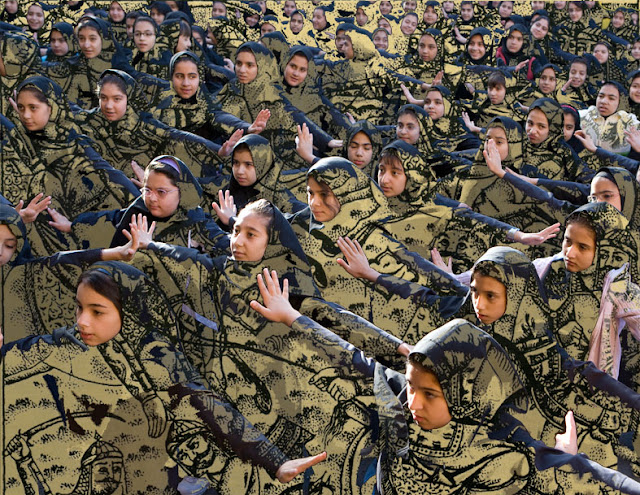Sadegh Tirafkan (July 3, 1965 in Karbala, Iraq – May 9, 2013 in Toronto, Canada) was an Iranian contemporary artist who lived mainly in Tehran, Iran.
Tirafkan employs different media in his work: photography, video installation, and collage. He graduated from Tehran University with a degree in Photography in 1989 and has participated in numerous solo and group exhibitions worldwide.
Tirafkan's work includes "Manhood", which deals with the perception of masculinity in Persian culture. Other projects such as "Persepolis", "Ashoura", "Secret of Words", "Iranian Man", "Whispers of the East", "The Loss of Our Identity", "Multitude" and "Devotion" deal with Iranian history, identity, sociopolitical, religious and gender issues.
His works are in the collections of several museums including the Tehran Museum of Contemporary Art, British Museum, Brooklyn Museum and the Los Angeles County Museum of Art.
Tirafkan employs different media in his work: photography, video installation, and collage. He graduated from Tehran University with a degree in Photography in 1989 and has participated in numerous solo and group exhibitions worldwide.
Tirafkan's work includes "Manhood", which deals with the perception of masculinity in Persian culture. Other projects such as "Persepolis", "Ashoura", "Secret of Words", "Iranian Man", "Whispers of the East", "The Loss of Our Identity", "Multitude" and "Devotion" deal with Iranian history, identity, sociopolitical, religious and gender issues.
His works are in the collections of several museums including the Tehran Museum of Contemporary Art, British Museum, Brooklyn Museum and the Los Angeles County Museum of Art.
Sadegh Tirafkan was born in 1965 in the city of Karbala, Iraq, into an Iranian family. In 1971, when he was six, Sadegh and his family migrated to Iran inevitably because of some political tensions. He was a juvenile when participating in courses of Institute for the Intellectual Development of Children and Young Adults (IIDCYA) and it was there he felt interested in art for the first time. A little later he faced up to the of eight year old Iran-Iraq war after the collapse of Pahlavi regime in 1979.
During the first years of Iran-Iraq war, Sadegh began to perform some theatrical events in mosques and some governmental centers. His future professional character and his work's origins were formed by the period of time when he was trying different artistic roles like directing, authoring, acting, puppetry, puppet and scene design, storytelling, being a producer and after all these, some experiences in short film-making.
During the first years of Iran-Iraq war, Sadegh began to perform some theatrical events in mosques and some governmental centers. His future professional character and his work's origins were formed by the period of time when he was trying different artistic roles like directing, authoring, acting, puppetry, puppet and scene design, storytelling, being a producer and after all these, some experiences in short film-making.
In 1984, although he was extremely interested in cinema and theatre, Tirafkan moved into Tehran and studied photography at College of Fine Arts in University of Tehran. Though Tirafkan was educated in art, he was ultimately largely a self-taught artist because he had shared little in common with the photographic mainstreams in art training at that time, and this is the reason his works show a strong break from with those of his predecessors. This is what he believed to be the distinction of his artworks.
After his death in 2013, Tirafkan's artistic heritage is preserved in the archive and museum of the Tirafkan Foundation in Tehran, which contains a huge number of photographs, short films, videos, installations, scenarios and multimedia pieces.Wikipedia
After his death in 2013, Tirafkan's artistic heritage is preserved in the archive and museum of the Tirafkan Foundation in Tehran, which contains a huge number of photographs, short films, videos, installations, scenarios and multimedia pieces.Wikipedia









No comments:
Post a Comment